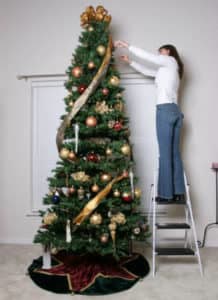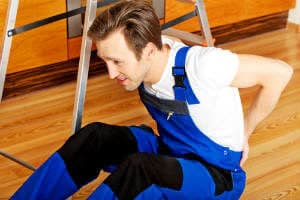You might not think that there would be a season of the year for fall injuries, but indeed there is.
During autumn and the holidays, falls from ladders are more common, according to federal statistics. People are putting up holiday lights and decorations.
One analysis of data by the Centers for Disease Control and Prevention (CDC) found that during the holiday season, defined as November 1 to January 31, there were more than 5,800 fall injuries per season related to holiday decorating over three years. Approximately 43 percent of them were caused by falls from ladders.
The majority of falls during the holiday season involve ladders. Of the people who fell from ladders, nearly half (47 percent) were hospitalized.
Fractures are the most commonly reported injury (34 percent) in all kinds of holiday-related falls, which also included falls from roofs and furniture (such as chairs), and from slipping or tripping and falling. Approximately half of the reported fractures were caused by falls from ladders.
Elsewhere, the Consumer Product Safety Commission (CPSC) says there are about 250 injuries a day during November and December. The most frequently reported holiday decorating incidents seen in emergency departments involved falls (34 percent), lacerations (11 percent) and back strains (10 percent).
These statistics for holiday-related falls do not count falls from ladders related to home maintenance and repair, such as the seasonal chore of cleaning leaves from rain gutters or off of roofs.
Accidents of all kinds are the 5th leading cause of death in Kentucky, according to the CDC.
Avoid Ladder Falls this Holiday Season
 The National Safety Council suggests that the potential for serious injury in a fall from a ladder is enough for many homeowners to leave gutter cleaning and holiday decorating to the pros. On the other hand, the NSC acknowledges that many of us are do-it-yourselfers.
The National Safety Council suggests that the potential for serious injury in a fall from a ladder is enough for many homeowners to leave gutter cleaning and holiday decorating to the pros. On the other hand, the NSC acknowledges that many of us are do-it-yourselfers.
Regardless of what chore you are facing in Lexington, Louisville, or Florence, KY, if it involves climbing a ladder, your friends at Becker Law Office want you to be safe to fully enjoy the 2016 holiday season.
Here are some ladder safety tips to keep in mind as you plan your work:
- Choose the Right Ladder. Remember that aluminum conducts electricity. Use wood or fiberglass instead of a metal ladder for electrical work. Consider the height you need. It is unsafe to use a ladder that is too long or too short for the job. Safety standards require a label on the ladder to indicate the highest standing level , and five categories of duty ratings indicate how much weight the ladder can safely support. Consider your weight as well as the weight of tools, decorations, etc. Do not assume that a longer ladder has a higher weight capacity, the American Ladder Institute says.
- Use a Sturdy Ladder. Before using a ladder, inspect it to confirm it is in good working condition. Don’t use ladders with loose or missing parts or ladders that sway, sag or lean to the side.
- Use Ladders in Safe Weather. Don’t start ladder work in windy or inclement weather. If bad weather arises — especially rain or thunder and lightning — get off of a ladder, take the ladder down, and wait for bad weather to pass.
- Set Your Ladder Properly. Place the base of your ladder on a firm, solid surface. Avoid slippery, wet or soft surfaces. If you must put the ladder on a soft surface, place a board under the ladder’s feet. But never use an object under a ladder to increase its reach. Make sure there are no slippery conditions at either the base or top support points of your ladder.
- Use Your Ladder as Intended. A straight or extension ladder should be placed 1 foot away from the surface it’s resting on for every 4 feet of the ladder’s height. Make sure extension ladders extend 3 feet above the roof or platform you’re trying to reach. A straight or extension ladder should be fastened to an upper support. Make sure a step ladder is completely open. Check the upper crossbars to ensure they are fully extended. Never stand higher than the third rung from the top.
- Use the Three-Points-of-Contact Climb. Maintain three points of contact as you climb to minimize the chance of slipping and falling from the ladder. While moving up or down or working on the ladder, face the ladder and have two hands and one foot, or two feet and one hand in contact with the ladder rungs. Climb slowly and deliberately. Avoid sudden movements. Keep your belt buckle (stomach) centered between the ladder side rails, and do not overreach or lean while working. You could lose your balance and fall.
- Equip Yourself for Ladder Safety. If you feel tired or dizzy, or are prone to losing your balance, stay off of ladders. Wear slip-resistant shoes with heavy soles to prevent foot fatigue. Make sure the soles of your shoes are clean to maximize traction. Don’t climb while carrying tools. Use a tool belt, towline, or an assistant to convey materials. Never have someone climb up to bring you something; only one person should be on a ladder at a time.
- Finish Ladder Work Safely. Never get off a ladder from the side. Climb all the way down. Never attempt to move a ladder while standing on it. Clean the ladder after each use to prevent dirt buildup, especially if it must be stored outside in wet or muddy conditions.

The American Ladder Institute has a downloadable ladder safety checklist suitable for printing out and posting in your garage or workshop as a reminder. The institute also has ladder safety videos, and a free ladder safety certification program for employers and employees.
Probably the best advice for ladder safety during the holidays is to take the time to do the job right. The extra time necessary to be safe will help ensure you can relax and enjoy the fruits of your labor over the coming holidays.
 The National Safety Council suggests that the potential for serious injury in a fall from a ladder is enough for many homeowners to leave gutter cleaning and holiday decorating to the pros. On the other hand, the NSC acknowledges that many of us are do-it-yourselfers.
The National Safety Council suggests that the potential for serious injury in a fall from a ladder is enough for many homeowners to leave gutter cleaning and holiday decorating to the pros. On the other hand, the NSC acknowledges that many of us are do-it-yourselfers.